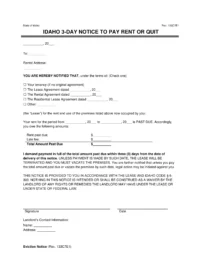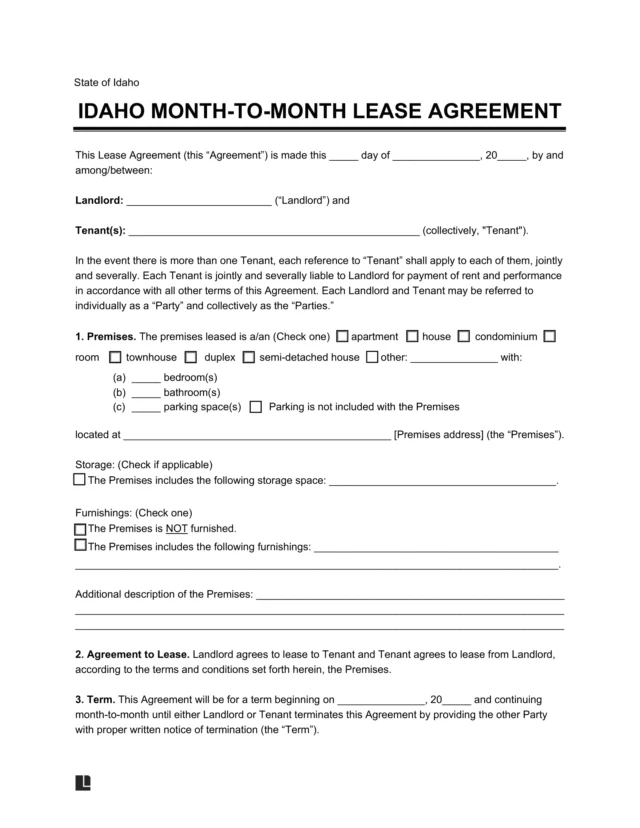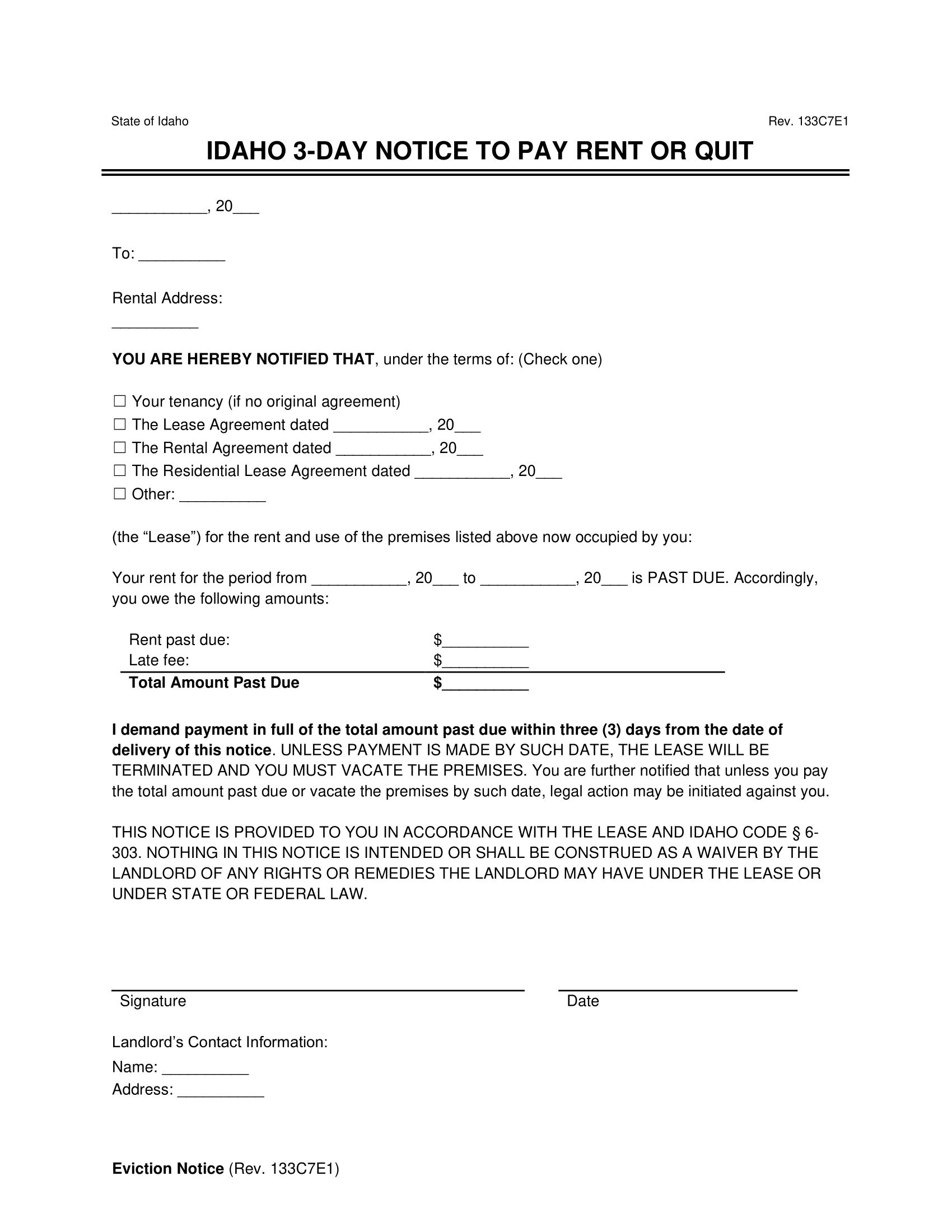Understanding Eviction Notices in Idaho
In Idaho, landlords are legally required to notify tenants in writing before filing for eviction. The notice must clearly state the lease violation, such as nonpayment of rent or breaking rental terms, and provide a deadline to comply or move out.
Eviction procedures are governed by Idaho Code §§ 6-301 through 6-324, which lay out required timelines: 3 days for rent issues or lease breaches, and 30 days for ending a month-to-month lease.
With Legal Templates’ document builder, you can generate Idaho-compliant eviction forms in just minutes.
Types of Eviction Notices in Idaho
Idaho landlords must choose the correct eviction notice based on the reason for ending the tenancy. State law sets strict timelines for each notice type, which must be followed to begin the eviction process lawfully.
3-Day Notice to Pay Rent or Quit
If a tenant fails to pay rent on time, Idaho law (ID Code § 6-303(2)) requires landlords to issue a 3-day notice demanding payment or possession. If the tenant doesn’t pay within 3 days, the landlord can proceed with an eviction lawsuit.
3-Day Notice to Pay Rent or Quit
Use this notice to quit to begin evicting a tenant if they haven’t paid rent on time.
3-Day Notice to Quit for Non-Compliance
Idaho Code ID Code § 6-303(3) allows landlords to serve a 3-day notice to cure or quit for other lease violations, such as unauthorized occupants, property damage, or repeated disturbances. If the issue is not resolved within the 3-day period, eviction proceedings may begin.
3-Day Notice to Quit for Non-Compliance
Give tenants a three day notice period before the eviction process can proceed in court. During that time, tenants may have the option to fix the problem.
30-Day Lease Termination Letter (Month-to-Month Tenancy)
To end a month-to-month rental agreement, landlords must provide 30 days’ written notice under ID Code § 55-208. This notice does not require any lease violation and ends the tenancy at the end of the rental period.
30-Day Lease Termination
Landlords and property management companies must give tenants a 30-day notice period to move out and end their month-to-month lease.
How to Evict a Tenant in Idaho
Idaho evictions are handled through a forcible entry and unlawful detainer action filed in district court. Here’s how the process works:
Step 1: Serve Eviction Notice on the Tenant
Giving the tenant the proper type of notice officially begins the eviction process. The notice must state the reason for the eviction and the date by which the tenant must either pay the rent, cure the lease violation, or vacate the property.
Landlords and property managers should serve notice via first-class, certified, or registered mail, personal service (a note taped to the front door), or process server.
Step 2: File an Eviction Lawsuit with the Court
If the tenant continues to stay on the property despite not paying the rent or complying with other lease terms, the next step is to file an eviction lawsuit in the district court where the rental property is located.
At this stage, you must prepare several documents and file them with the court, including the summons and complaint, as shown below:
- General Civil Case Information Sheet
- Complaint for Unlawful Detainer
- Summons for Eviction
Step 3: Serve the Tenant
Once you’ve filed the necessary documents with the court, you must legally serve the tenant with them. The process server will complete the Affidavit of Service of Summons & Complaint and serve the tenant the relevant paperwork. Follow these directions for help.
Step 4: Prepare the Necessary Documents for the Court
The tenant has 5 days from the date they were served with the summons and complaint to respond (file an answer with the court admitting or denying the allegations in the complaint).
If the tenant doesn’t respond, the landlord can prepare the required documents for a default judgment to repossess the premises, which include:
- Motion and Affidavit for Entry of Default Judgment
- Memorandum of Costs
- Judgment for Eviction
- Writ of Restitution of Premises
Step 5: Attend the Hearing
If the judge rules for the landlord or the tenant fails to respond, the judge will sign the necessary documents to complete the eviction process.
The landlord can give the appropriate law enforcement officer the Writ of Restitution of Premises to reclaim the rental unit. Landlords who want to claim monetary damages from evicted tenants must do so in small claims court.
Related Idaho Court Forms
- General Civil Case Information Sheet – This document provides basic information to identify the parties and the type of civil case. It’s filed with the court clerk when the complaint and summons are filed and officially opens the case.
- Complaint for Eviction – This document states the legal basis for the eviction and asks the court to evict the tenant. It lists the amount of money the tenant owes.
- Summons for Eviction – This document notifies the tenant that a case has been filed against them and provides the date, time, and location of the trial.
- Motion and Affidavit for Entry of Default Judgment – In this document, the landlord attests that the proper legal procedures have been followed, the tenant did not respond to the complaint and did not appear at the hearing, and asks the court to enter a default judgment against the defendant.
- Memorandum of Costs – The landlord completes this document to show the amount of money incurred by the landlord, including the service of process fee and the filing fee.
- Judgment for Eviction – Once signed, the Judgment for Eviction legally orders the possession of the rental unit to be returned to the landlord and for the tenant to vacate the property.
- Writ of Restitution of Premises – This document gives the sheriff the legal authority to physically remove the tenant from the rental property.








